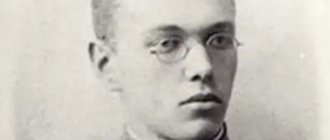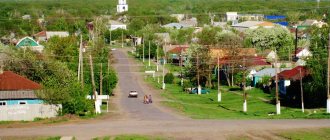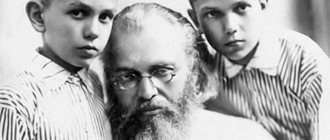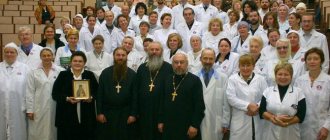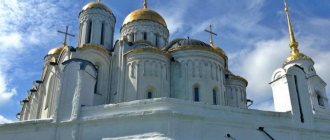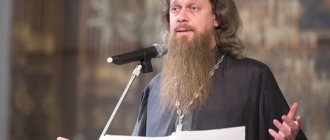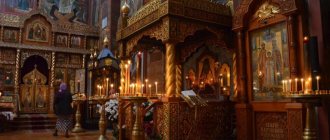Greetings, friends!
We have already visited, virtually or in reality, the main epicenter of the Crimean peninsula, Simferopol. Let's figure out what useful things you can do here if you don't see the goal of flying headlong to the South Coast immediately after landing.
Of course, you can immediately begin exploring Sevastopol or Yalta using our guides, but they say that the Relics of Luka Crimea in Simferopol have miraculous powers. Therefore, it is here, to the Holy Trinity Cathedral at the convent, that pilgrims from all over the world come every year.
Let's figure out how Saint Luke ended up in a nunnery, and who was this man in real life - an unsurpassed surgeon or a holy healer?
A little biography
Valentin Feliksovich Voino-Yasenetsky, future Archbishop of St. Luke of Crimea, was born in 1877 in the city of Kerch. He was brought up in a large family, besides him there were four more children.
He received his education at the Kyiv gymnasium, was seriously interested in art, but went to enter the medical faculty.
Valentin did not succeed in becoming a medical university student on his first try. He was driven by a desire to help the poor, sick and unfortunate. Therefore, he achieved his goal - he became a diligent medical student, and upon completion of his studies, a zemstvo doctor.
From this moment begins the big and main story of Valentin Feliksovich’s life, which led him to religion and the priesthood.
Answers to prayers near holy relics
- Little Vanya suffered from an umbilical hernia, the young mother insisted on surgery on the recommendation of doctors, and the believing grandmother went to Simferopol and brought sacred oil. The woman lubricated her hernia with it and prayed at the icon of the saint. The hernia disappeared on its own, without surgical intervention, by the great grace of a great doctor and the love of God.
- Anna dreamed of becoming a doctor, the competition at the medical institute was very strong, every day the girl and her mother went to the akathist and applied for cancer. After passing the exams, the girl was enrolled in a medical institution. There was no end to the surprise of doctors when a woman preparing for surgery to remove an ovarian cyst found no tumor. He disappeared after the patient visited the Holy Trinity Cathedral and the relics of Luke the Crimean.
- According to a woman from Georgia, her aunt for a long time could not get rid of a headache, the cause of which doctors could not determine. Having learned about the miracles of the saint from a friend from Simferopol, they bought an icon of the saint and all watched the film “Saints of the 20th Century” together. The aunt applied oil transferred from the saint’s sanctuary to her temples during daily prayers, applying the icon to her head, and one night in a dream she felt that she was being operated on. It was very painful, but the woman could not wake up, someone’s hands pulled something out of her head, anointed her with oil, and the next morning her aunt was healthy. In gratitude to the saint, the newborn grandson received the name Luke, having a reliable and faithful angel-savior.
- A patient with cerebral palsy was diagnosed with tendon hygroma, and a third operation was scheduled. This was in Moscow, and the patient often went to church with particles of the saint’s relics and addressed them with sincere prayer. There was no end to her joy and surprise when, after another MRI, the doctor said that it was fibroids and not curable oncology.
Many believers testify not only to healings, but also to other answers to prayers:
- Oleg Bykov thanks the archbishop for eradicating alcoholism.
- Svetlana Astasheva implored the sacred image of her father, who, being an atheist, was baptized at the age of 88.
- Viktor Sakhnov testifies that the Archbishop of Crimea became his guardian angel for all the days of his life, be it illness, financial problems or difficulties in his personal life. After sincere prayer, an answer always came about what to do in a given situation.
Important! The list of miracles performed through the prayers of the Crimean saint can be continued endlessly. The holy book of the Bible says that by faith it will be given to you (Matthew 9:29).
Activities and fatal moments in life
The future great surgeon V.F. Voino-Yasenetsky studied a lot and diligently, worked, developed new techniques in surgery and anesthesiology, wrote dissertations and works, which later became training material for other doctors.
In addition, he had his own religious beliefs, always put helping those in need first, and was not a supporter of the political views of the Soviet regime . For this, he was put on trial several times, serving sentences in prison and exile.
Professor, doctor of medical sciences, scientist - he always came to the aid of the sick, mentored students, and continued to work on his books even in prison.
Professor Voino-Yasenetsky was married and had four children . After the death of his wife, he strengthened his faith in the Lord, began to attend divine services, and actively took part in conversations about the Holy Scriptures and church affairs.
In 1921 he was ordained a deacon, and in 1923 he was tonsured a monk, given the name Luke - in honor of the Evangelist Luke, who was also involved in healing and art. Soon he was elevated to the rank of bishop.
Return to Crimea
After long ordeals, in April 1946 the archbishop was transferred to Simferopol, to the Cathedral of the Crimean Diocese. Here he spent the final part of his life.
The Crimeans knew and loved Bishop Luka of Crimea for his virtue but strong character.
Continuing to help those in need both by deed and by the word of God, he was still not pleasing to the authorities. They forbade him to give medical lectures - after all, at that time Orthodox churches and temples were closed en masse.
In the last years of his life, being blind, he continued his work through his assistants. He dictated letters and works, so much did he want to pass on his experience to the future generation. And on June 11, 1961, Bishop Luke passed away.
He was buried at the first Simferopol cemetery, next to the Church of All Saints . For his merits, firm and unshakable faith, help to the suffering and sick, Archbishop Luke of Crimea was canonized.
They say that prayer at his grave, as well as water and earth taken there, helped Orthodox and believers many times.
In March 1996, the archbishop's relics were recovered in the most solemn manner and transferred to the cathedral.
The history of the appearance of a sacred place
Like many ancient churches, the Church of St. Luke in Simferopol now looks completely different than at the beginning of its existence, and its “life” was full of different events.
On the spot where it now stands, a small wooden church was erected back in 1796; it belonged to the Greek church. By the way, this served it well during the years of persecution of faith in Soviet times: the authorities were somewhat wary of such churches, so as not to spoil relations with other states. At the beginning of the 19th century, the entire area where the Holy Trinity Cathedral was located was inhabited by Greeks, so a Greek gymnasium was opened in the temple building. But the small wooden structure was not suitable for long-term and active use. In the middle of the century it was dismantled in order to build a new temple complex, more spacious and made of stone, on the vacant site. The author of the project was the architect I. Kolodin.
The architect used classical architectural forms for his project. The plan of the church is cruciform, crowned in the middle with an octagonal dome, to the left of which there is a low bell tower. Noteworthy is the sophistication of the facade, decorated with pilasters, columns, and an abundance of mosaic paintings. Inside, it is divided into two chapels: one is dedicated to the Cathedral of the Crimean Saints, the second to Saints Helen and Constantine.
The Orthodox community of Simferopol experienced hard times during Soviet times. All the main churches in the city were blown up, only this one survived. For a long time it remained the Cathedral of the Crimean Diocese. The two clergymen leading it were driven into the camp and shot. In 1946, Archbishop Luka of Crimea became the local rector, after whom the Trinity Church is now called.
Greek Church of Saint Luke
In 2002, the cathedral received a gift from the Greek Church - a silver shrine, in which the relics of the archbishop rest to this day.
You will be surprised, but in Greece, thanks to his works and activities, Luke is very revered. In memory of him, prayer services are held and conferences of many thousands gather, and throughout Greece there are about 30 temples named after him.
Behind all this is Archimandrite Nektarios . Having once read a book written by St. Luke, he fell in love with this man with all his soul, studied his entire biography and immortalized his name within the walls of the Greek church.
It is in Greek temples that there are icons with the image of St. Luke with a medical instrument in his hand.
All this, of course, is not accidental, because on the site of the current cathedral and monastery, the first Greek church was built in 1796, and later a Greek gymnasium was opened. And the street was called nothing less than Greek.
To holy places. Simferopol. Saint Luke (Voino-Yasenetsky). Part 2
Audio |
A new episode of the program will tell about the Holy Trinity Convent in Simferopol and the discovery of the relics of St. Luke of Crimea.
On the site of the main temple of the monastery there was previously a wooden Greek church, which was founded in 1796. Over time, the old church was dismantled, and in 1868 a new spacious Holy Trinity Cathedral was built and consecrated. Archpriest Vladimir Kashlyuk, rector of the Church of All Saints: - This year is an anniversary year for the Simferopol and Crimean diocese, as we honor the special memory of our Saint Luke, confessor, archbishop of Crimea, patron of all Crimeans. This year marks 100 years since the episcopal consecration of St. Luke, who took holy orders in order to serve God and people. March 18 marks the 25th anniversary of the discovery of his honest, incorruptible relics at the necropolis of the All Saints Church. Also this year, June 11, marks the 60th anniversary of the blessed death of our archpastor.
Now the relics of St. Luke reside in the Holy Trinity Cathedral in Simferopol. Every year, on the days of celebrating the memory of the saint, as well as on weekdays, believers come here with prayer to the Lord God and His holy saint. Back in 1796, in Simferopol, on the site of the current Holy Trinity Convent, a wooden parish church of the Holy Trinity was built for the Greeks living in the city. Even the street was called Greek, because the descendants of the ancient Hellenes lived here for a long time. In 1868, the wooden church was replaced by a stone one, and in 1930, when the authorities destroyed the Alexander Nevsky Cathedral in Simferopol, the Trinity Church became a cathedral. The authorities wanted to destroy this church too, but the Greeks did not allow it - in 1934 the parishioners achieved, through the Greek Mission in Moscow, the return of the temple to the church community. The walls of the Holy Trinity Cathedral remember the prayers and sermons of St. Luke (Voino-Yasenetsky). From 1946 to 1961 he was Archbishop of Crimea; 60 years ago, Vladyka departed to the Lord and was buried at the All Saints Cemetery in Simferopol.
Archpriest Vladimir Kashlyuk:
– Before the Holy Synod of our Church decided to glorify our archpastor, Archbishop Luke of Crimea, as a locally revered saint, several factors were taken into account: the holiness of a person’s life, popular veneration and those miracles that must be performed even before canonization. I want to emphasize that the first miracles took place here, at this holy place - people came to the grave, knelt down, anointed themselves with oil, took some land, asked St. Luke as a doctor, as a surgeon, that their health would improve, and many received healing here.
On November 22, 1995, by the decision of the Synod of the Ukrainian Church, Archbishop Luke of Simferopol and Crimea was canonized as a locally revered saint. In March 1996, the discovery of his honest relics took place.
Archpriest Vladimir Kashlyuk:
– His incorruptible, celibate relics were found in 1996 on the night of March 17-18 in this holy place by our Bishop, Metropolitan Lazar of Simferopol and Crimea. Since that time, for a quarter of a century, our Church has especially honored this day, because we have found a new intercessor, our patron, doctor and miracle worker, who constantly prays for those who call on his name.
On the night of March 17-18, 1996, during the Week of the Worship of the Cross, members of the diocesan commission for the canonization of saints, governors of Crimean monasteries, and clergy gathered in the All Saints Church in Simferopol - and at approximately two o'clock in the morning they opened the grave. Vladyka Lazar raised the relics of the saint with his own hands.
Archpriest Vladimir Kashlyuk:
– After the discovery of the honest and incorruptible relics of Archbishop Luke of Simferopol and Crimea, with the blessing of Bishop Lazar, his incorruptible relics remained in the All Saints Church for three days. Here, in this place, in the left aisle of our temple. And today, a piece of the relics of St. Luke is symbolically present here in memory of those events that took place a quarter of a century ago. For three days the Liturgy of the Presanctified Gifts was celebrated here, headed by the ruling bishop, and on March 20, from the Church in the Name of All Saints, the incorruptible healing relics of St. Luke with a host of clergy and the people of God were transferred to the present Holy Trinity Monastery, where they rest to this day.
On March 20, 1996, a religious procession with holy relics began from the cemetery church.
Metropolitan Lazar, Simferopol and Crimea:
– Let the procession of the cross be our spiritual unity, unity in the sense of goodness, justice of Christian love. Let our religious procession be the beginning of social cleansing, cleansing for the sake of creating something new and spiritual in our lives. Remember your mentors who preached the word of God to you, and, looking at the end of their lives, imitate their faith.
The procession was accompanied by officers of the Black Sea Fleet, students of the Crimean Medical Institute, city residents, and numerous guests.
Metropolitan Lazar:
– Today our soul sparkles with special joy and our heart warms with special warmth – The Orthodox Church with great reverence receives the relics of the saint of God, the representative before the Throne of the Most Holy Trinity, professor of medicine, learned archpastor Archbishop Luke (Voino-Yasenetsky), canonized by the decision of the Holy Synod of the Ukrainian Orthodox Church saints who shone in the land of Crimea.
Behind the coffin, along with the priests, were those who had the good fortune to witness the life and feat of Archbishop Luke.
Metropolitan Lazar:
– The saint himself did not perceive his life as a feat, but set an example of confession. His life passed through difficult times, he put a lot of work, a lot of strength in the field of Christ, without leaving his medical practice, which he considered as a continuation of pastoral activity, understanding the spiritual root cause in bodily ailments. In turbulent and difficult times, our intercessor has appeared. A person, a people, who has entered the path of sin cannot turn away from it without repentance, without help from above...
Now in the Holy Trinity Cathedral every day there is a fervent and fervent prayer to God, through an appeal to the saint for help. In 2001, the relics of St. Luke were placed in a silver shrine, sent as a gift from Greece, and a year later the Holy Trinity Cathedral was converted into a convent. And nearby, in the Museum of St. Luke (Voino-Yasenetsky), which is located in the courtyard of the Holy Trinity Cathedral, testimonies of people who were helped by St. Luke of Crimea are kept.
Natalya Malyuta, employee of the Museum of St. Luke (Voino-Yasenetsky):
– In my hands I hold a book in which people left their notes about healing and miracles. I want to tell you a recent incident. A family from Moscow flew in to thank St. Luke for the healing. In December 2022, the family fell ill with a new coronavirus infection, the husband had 50% lung damage, swelling of the heart began, and he was admitted to the hospital. The wife did not pray to Saint Luke, but when she fell asleep on the second night, she dreamed of Saint Luke and said that he would help and take her husband under protection. She and Saint Luke ended up in her husband’s room, and when she woke up, she called her husband and told her about her dream. She said that they even visited his room, he was very surprised, because she described the room exactly. After that dream, my husband recovered very quickly, after five days he was discharged, he recovered very quickly, as from a regular ARVI.
And we constantly tell another case. In 2001, from the Murmansk region, Nazar and his mother came to visit his grandmother on vacation in Crimea, in Feodosia. Apparently there was some kind of draft, and the iron door with a lock slammed his middle and ring phalanges of fingers. His phalanges were simply dangling, the surgeon could simply amputate them, and no other option was found. The boy cried a lot because at the age of 10 he could play the piano, and when they went to the Kazan Cathedral in Feodosia, they were told about St. Luke and told to go and pray to him. They arrived in Simferopol, they asked, the boy himself asked as best he could: “Saint Luke, I don’t know how you will do this, help me, I really want to play the piano.” Mom bought him a small laminated icon, an oil consecrated on the relics of St. Luke. They began to apply the icon to his fingers, anoint them with oil every day, and within three weeks the boy’s amputated fingers grew back. Nazar is already an adult, he is 30 years old, he continues to play music professionally.
People also come to the grave where the body of the saint lay for 35 years.
Archpriest Vladimir Kashlyuk:
– Every Sunday during the warm season we perform water prayer services here, at the grave of St. Luke, begging for all those who need his help as a doctor and miracle worker. Many still support the tradition that existed even before canonization: they write notes with personal requests to St. Luke and also receive healings. I can testify that in the life of my family, my relatives and friends, various healings were also performed, which brought me to the church from childhood. I remember the period (just 25 years ago) when my grandfather underwent a very complex operation. Before the operation, the doctor said: “Let the man die in peace.” But we all knelt and prayed to Luka Krymsky, and a miracle happened - the operation was not only successful, but grandfather is still alive. This was our first experience of churching as a family. I am grateful to God that thanks to such saints and archpastors that the land of Crimea has, in particular our Saint Luke of Crimea, many find the way to the Church for the salvation of their souls.
During his 38 years of priesthood, Archbishop Luke preached 1,250 sermons, of which 750 were recorded. An audio recording of his address to the flock on the Feast of the Transfiguration of the Lord has been preserved.
Saint Luke (Voino-Yasenetsky):
- But let's not despair. Let us remember that there is still a small flock of Christ, that flock for which the light of Christ, the light of Tabor, still shines with the same power with which it shone for the three chosen apostles. Let us remember what our Lord Jesus Christ said to this chosen flock: “Do not be afraid, little flock, for it has been your Father’s good pleasure to give you the Kingdom.”
Archpriest Vladimir Kashlyuk:
– The experience of 25 years of veneration of St. Luke shows us that he is with us, he has not left us, he not only prayerfully supports, but also directly heals all those who turn to him, kneeling before his holy healing relics, coming to the grave , to this sacred and revered place. “Holy Saint, Our Father, Luke, pray to God for us, heal and help us all!”
Author and presenter of the program Nadezhda Kalinina
Recorded by Elena Churina
Where are the relics of St. Luke in Crimea
The relics are in the Holy Trinity Cathedral at the convent. A museum named after him is also opened here.
Address: st. Odesskaya, 12
Official website: svtluka.org.ua
On the website you can see the schedule of services, as well as the opportunity to order a service, liturgy and prayer service.
Please note that this is the official website and donations should only be made here. Many scammers have appeared on the Internet who consider it their duty to scam the laity out of money.
How to get to the temple
Simferopol is located in the center of the Crimean peninsula. The main federal routes pass through it.
Within the city there are:
- airport of the same name;
- Train Station;
- bus station.
The developed infrastructure inside the capital will make the journey easier for inexperienced tourists.
Public city transport is represented by:
- minibuses;
- by bus;
- trolleybuses.
To easily reach your destination, you can use the instructions below.
By car
You can get from the Krasnodar Territory to Crimea via a modern bridge connecting the peninsula with the mainland through the Kerch Strait.
The route is as follows:
- You should take the federal highway A290 to Kerch and the Crimean Bridge.
- From the bridge you need to move 210 km in a westerly direction following the signs towards the city of Simferopol.
- Having entered Simferopol, you need to continue driving along the main Pobeda Avenue to the city center until Kirov Avenue.
- On the 3rd ring road you need to drive straight past the Park of Forged Figures until the intersection with the street. Odessa.
- At the intersection of the street. Odesskaya and Kirov Ave. turn right.
- After 5 min. on the right side there will be an entrance to the Church of St. Luke.
The Church of St. Luke in Simferopol has guest parking for visitors' transport. Coordinates: 44°56′57″N (44.949072), 34°6′15″E (34.104049).
By public transport
The location of the attraction is very convenient.
The temple can be reached by any type of public transport:
- From the train station you need to take a minibus or trolleybus to the Lenin Square stop (5th stop). Any route towards the center, except trolleybus No. 8, is suitable. Next, cross the street at the transition to the Assorti shopping center and go around the building on the left.
- From the bus station in the direction of the center you need to take minibus No. 114 and get off at the same stop. Travel time will take no more than 15 minutes.
- From the airport to the Lenin Square stop there is a trolleybus No. 9 and a bus No. 98. The journey will take about 45 minutes.
The cost of one trip by bus, trolleybus or minibus is 17 rubles. The price is valid from April 1, 2022. Residents and guests of the city can use taxi services. The cost of a trip from anywhere in the city will not exceed 130 rubles.
How to get to the relics of St. Luke
The Holy Trinity Convent is located almost in the center of Simferopol. From the railway station you need to get to Lenin Square for reference. If you don’t see the dome of the cathedral yourself, ask any passerby - they will direct you.
In Crimea, the Holy Trinity Cathedral, where the relics of St. Luke is called the Temple of Luke.
The cathedral is open from 7.30 to 18.00 . The window on the silver shrine for application to the relics opens on Fridays from 7.00 am.
Relics
The Orthodox relics stored here are of particular value.
Icon of the Mother of God “Sorrowful”
In 1998, a dull old icon came into the monastery from the hands of a parishioner. Two weeks later, the parishioner came again and noticed that the icon had become brighter, as if it had been replaced. The icon itself is quite unique; it has no analogues in icon painting. The Synod of the Ukrainian Orthodox Church blessed the veneration of the icon and in 1999 it was carried across the entire peninsula.
Panorama near the Holy Trinity Church — Yandex.Maps
Relics of Saint Luke
Luke was canonized as a locally revered saint in 1995, and six months later his relics were transferred to the Holy Trinity Monastery. Today they are kept in a silver shrine, donated by the Greeks. They say that after praying to Luke, some sick people recovered.
